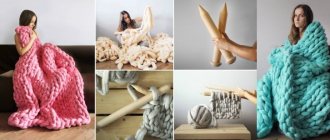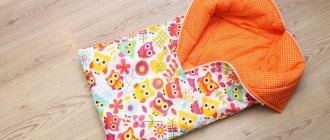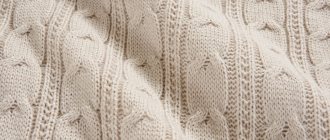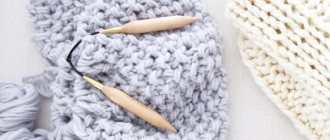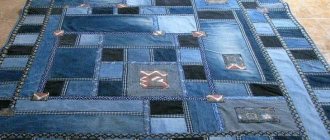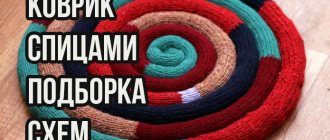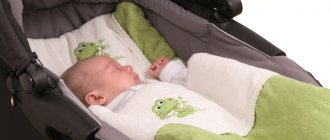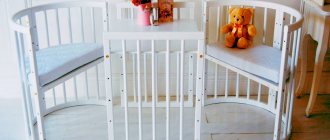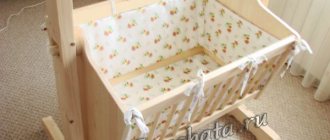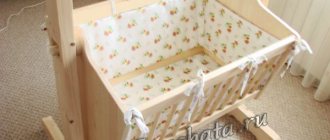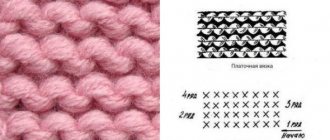Alize Puffy is a Turkish yarn. Composition: 100% polyester. Very soft and pleasant to the touch. Alize Puffy yarn is hypoallergenic and great for children.
Alize Puffy yarn consists of loops for hand knitting, without using a hook or knitting needles. The manufacturing process is very simple, fast and enjoyable. With the help of Alize Puffy you can knit a lot of fashionable, cozy and warm things. It's worth just trying.
Can you crochet? Publish your work on kru4ok.ru
Knit original snoods, braided blankets, toys, pillows and much more without any tools! The soft loops of Alize Puffy will not leave anyone indifferent. But it is not suitable for those who cannot tolerate artificial fibers. If you cannot wear polyester items, then you should not knit items from Alize Puffy. Blankets and toys are welcome, but not robes, snoods or cardigans.
Characteristics of Alize Puffy yarn
- The weight of one skein of Alize Puffy is 100 g.
- Alize Puffy thread length is 9 meters.
- The Alize Puffy package contains 5 skeins, enough for one blanket for a newborn.
Caring for Alize Puffy blankets with a braided pattern
Caring for Alize Puffy blankets with the Braided pattern and more is very simple - hand wash at a temperature of no more than 30 degrees. Hand press only, gentle. Drying a blanket from Alize Puffy Braided on a horizontal surface. You can't iron. If you follow all the recommendations, the Alize Puffy Braided blanket will retain its appearance and functionality for a long time.
Alize Puffy yarn is an innovation in the world of knitting!
Alize Puffy is a chenille yarn (with short pile) from the Turkish factory, with ready-made loops of 4 cm, for which no knitting needles or hooks are needed, you only need your fingers. Composition of Alize Puffy: 100% micropolyester.
Yarn consumption for a blanket from Alize Puffy knitted with the Braided pattern
Many people ask the question, how many skeins of yarn will Alize Puffy need to knit a Braided blanket 100*100 cm? Or 150*200 cm? Or maybe even 220*220 cm?
The answer is quite simple, there is a certain formula for calculating Alize Puffy yarn for a Braided blanket:
- Length * Width * Constanta = number of skeins of Alize Puffy.
- Constanta is a constant, unchanging number. In our case, this is the number of skeins of Alize Puffy per 1 square meter (for Braided).
- One square meter of Braided blanket contains 7.25 skeins of Alize Puffy yarn.
- Knowing the length, width and constant number, you can easily calculate how many skeins of Alize Puffy we need.
ATTENTION! The formula is designed only for the “BRAID” pattern made from Alize Puffy yarn!
- interesting selection on kru4ok.ru!!!
- How to crochet a blanket for the home
- … And
Example 1 for calculating yarn for a blanket from Alize Puffy Braid
We want to knit a Braided blanket from Alize Puffy with a length of 120 cm and a width of 100 cm, what we get: We convert our dimensions into meters, respectively, we get 1 meter length and 1.2 meters width.
We calculate: 1*1.2*7.25=8.7 (skein) We will need 8.7 skeins for a braided blanket measuring 100*120 cm, because We cannot buy exactly 8.7 skeins, so we round to the nearest whole number and get the number 9, respectively, 9 skeins will be needed for a Braided blanket 100*120 cm.
Example 2 for calculating yarn for a blanket from Alize Puffy Braid
We want to knit a Braided blanket from Alize Puffy with a length of 220 cm and a width of 220 cm, what we get: We convert our dimensions into meters, respectively, we get 2.2 meters long and 2.2 meters wide.
We calculate: 2.2*2.2*7.25=35.09 (skein)
We will need 35.09 skeins for a braided blanket measuring 220*220 cm, because We cannot buy exactly 35.09 skeins, we round up to the nearest whole number and get the number 36, respectively, 36 skeins will be needed for a blanket 220*220 cm. The remaining thread can be used for fringe around the Braided blanket. I hope this information is useful to you!
The calculation for the Braided blanket from Alize Puffy was @
Teddy bear in half an hour!
The video should load here, please wait or refresh the page.
Calculation of loops for a blanket Braided from Alize Puffy yarn
Catch an approximate calculation of the number of loops for knitting a blanket from Alize Puffy (the “Braided” pattern), you can cast on one more or less stitch (an even or odd number), for the symmetry of the Braided pattern (I think a difference of 2 - 3 cm is not so bad) .
According to our calculations: 1 pet. = 1.7 cm 10 sts. = 17 cm, but Alize Puffy’s yarn comes in different thicknesses, so I recommend that you first knit a sample of 10 loops and calculate it yourself! For a Braided Alize Puffy blanket 200 cm wide, you need to cast on 118-120 loops.
Choosing yarn for a blanket
Plush is a type of velvet. It can be made from a variety of materials, including:
- cotton;
- silk;
- wool;
- linen;
- synthetics.
Also, plush is often a combination of synthetic and natural fibers.
For children, the best option is cotton. Compared to other materials, it has a number of advantages. The following can be mentioned as the main ones.
- Naturalness of the material. Cotton will not cause an allergic reaction or irritation on delicate baby skin.
- Soft texture. Unlike other materials, cotton textiles are very soft and do not rub the baby’s skin.
- Easy to care for. Cotton does not require complex care; normal washing rules are quite applicable to it. In addition, stains and other contaminants are easily removed from this material. This is especially true if it will be used by a small child.
Wool yarn is also often used. However, its choice must be taken more responsibly - it should be as soft as possible and in no case should it prick. Otherwise, the material may injure delicate baby skin. The wool must be 100% natural.
When you have decided on the material, you need to choose a textile brand. Among the trusted brands that offer high-quality products for purchase are the following.
- YARNART. Turkish manufacturer of yarn and other textile products. Mainly produces wool and cotton plush. Products of the middle price category - one skein of yarn will cost approximately 150 rubles.
- Alize. Another yarn manufacturer from Turkey. The company's product range includes a wide variety of textile types - from natural cotton to synthetics. Alize products are inexpensive - for one skein of yarn you will need to pay about 100 rubles.
- Vanity. Expensive yarn made in Italy. It is distinguished by the use of exclusively natural materials. It is 1.5 - 2 times more expensive compared to Turkish analogues - the price of one skein is in the range from 250 to 300 rubles.
- Kartopu. Inexpensive Turkish yarn. Quite high quality. Costs from 100 to 150 rubles.
Where to buy giant yarn
When I finished last year's fall reading nook project, I set about finding yarn. I searched on the Internet for “thick wool”, “giant plaid” and found strange groups that were engaged in joint purchases in Chinese stores. This didn't inspire confidence in me.
I wanted to trust the photographs, that in the end I would receive what is in the photo in my order, and I would order exactly the amount of yarn that is enough for a blanket of the right size. I reviewed so many sites that spring had already arrived and the project was postponed until autumn.
At the beginning of September, I found the Cozy Store website, which sells knitting yarn. This was what we needed! The store is in Moscow, but the parcel arrived in St. Petersburg in 3 days.
Crochet a blanket
For most types of knitting, a hook with a length of 12 to 16 centimeters is suitable. Tools can be made of steel or plastic. It is better to choose a metal product - it will last much longer. The presence of a handle is important - it promotes better retention (as a result, the quality of work improves).
Here are some tips for beginners.
- The hook is perhaps one of the most important components of the work. Therefore, you should not save on it under any circumstances. It is better to spend on an expensive instrument and enjoy creativity and its results, than to have difficulties with a cheap and low-quality one.
- If you make a mistake, it is better to undo everything that was tied after it and tie the wrong section again. Otherwise, you can easily ruin the entire product.
- It is better to start your practice with the easiest schemes. Otherwise, due to the difficulties that arise, a beginner may simply give up knitting. From simple things they gradually move on to more difficult ones. This transition must be made when simple techniques have been fully mastered and mastered to perfection.
For beginners, it is best to use the following patterns:
- zigzag;
- columns;
- ticks;
- granny square.
Let's take a closer look at them.
Zigzag pattern
Zigzak is a simple pattern that is ideal for beginners. Here is his diagram:
- first make the required number of air loops depending on the length (for a meter-long blanket their number will be 100 - 120);
- then make 3 lifting air loops;
- then make 7 double crochet stitches and 3 more in one step.
The third step is repeated until the creation of the blanket is completed.
Description of the pattern Braided blanket
The Braided pattern is the most popular for knitting blankets from Alize Puffy. That is why we decided to tell you more about it. The size of the blanket with the Braided pattern is 85*85 cm.
- Count 50 stitches from Alize Puffy yarn. Cross the 49th and 50th loops, the 51st and 52nd loops coming from the skein, pass through the crossed loops, bringing them to the front side of the braided pattern.
- Thus, cross all the stitches in pairs. Alize Puffy and knit them with the stitches coming from the skein, in the same direction. In the next rows, do not turn the work around. Knit from left to right and right to left.
- In the 2nd row, first st. do not knit, 2nd and 3rd pet. cross each other in the opposite direction to the direction of crossing the loops of the previous row. In this way, cross stitches in pairs, moving from left to right to the end of the 2nd row.
- Last pet. don't knit. In the 3rd row, 2nd stitch. cross with unknitted st. the previous rad - also in the opposite direction. This creates a braided pattern. Knit a blanket using the Braid pattern from Alize Puffy in height using the required number of stitches.
Knitting a blanket with knitting needles
Knitting needles are suitable for more experienced craftswomen. Knitting with them is somewhat more difficult, but the finished product will be softer and smoother.
For beginners, the grain pattern is suitable. To put it into practice, you need to:
- divide the blanket into squares (approximately 15 x 15 centimeters);
- alternate squares in a checkerboard pattern using knit and purl stitches until a pattern is formed.
Beginning of work
STEP 1 So, first you need to decide on the size and color of your future blanket with pom-poms, since the materials that we will use depend on this.
Materials
- Wool yarn in two colors 400 m.
- Plywood or wooden planks (the size corresponds to the size of the future blanket plus 10-15 cm.)
- Large slate nails
- Scissors
Frame
STEP 2 First, we need to make a frame for weaving, or the so-called lum.
Frame (lum) for making a blanket
There are two ways to solve this problem:
- make it from plywood , then it will be more durable, but heavier and will take up a lot of space,
- make a lightweight frame from planks that can be disassembled, but it will not be particularly strong.
For the next step you will need the help of the stronger sex.
Ask your man to connect the planks. Along the edge, every ten centimeters, there are marks on the planks or plywood into which nails must be driven.
Your frame is ready and you can move on to the next step.
Plush plaid with hands without knitting needles
Those who do not want to learn to knit, but want a blanket of their own making, can use special yarn that can be used without additional tools. This is possible thanks to the presence of special hinges made directly at the factory.
Knitting such a blanket is very simple - just insert the loops into each other. They are quite large, so this will not be a problem. Such a handmade product is no worse than traditionally knitted one.
You can see the process of creating such a blanket here:
The history of the plaid
Do you know where the blanket came to us from? What is its origin?
Blankets came to us from Scotland many centuries ago. For the mountaineers, a blanket was a universal outerwear; they wrapped themselves in it to escape the weather, and covered themselves with it while sleeping.
Each family (or clan) had its own original design that was used to decorate the blanket; from this design it was always possible to determine which area and which clan its owner belonged to. The design was applied with special sticks and consisted of various checks and stripes; the checkered design is still called “Scottish”.
Scottish plaids were called tartan (TaurTan), which translated means the color of the area. Each clan had its own unique tartan, a kind of passport.
Tartans were made exclusively from sheep wool and dyed with natural vegetable dyes using a special technology that has not survived to this day, since in 1746 the highlanders were banned from wearing tartans and kilt skirts, and the special sticks used in production were destroyed.
Only three clans managed to preserve their tartans, since their colors were close to the government ones. During this ban, the Scots began to use tartans as bedspreads - rugs (Plaid - bedspread). Tartan plaids were also worn as a sign of belonging to one class or another. For example, for servants a one-color design was intended, for peasants - from threads of 2 colors.
A three-color taratan was used by craftsmen, and plaids with four colors were used by the military. A five-color plaid indicated that its owner was a singer, a six-color plaid indicated that its owner was a military leader. Only the head of each clan was allowed to wear a tartan of seven colors. For Scotland, the checkered plaid has become a symbol of the country's independence. Throughout the long history of the Scots’ struggle for sovereignty, the British have repeatedly banned the wearing of plaids as national clothing.
Today there is a huge variety of blankets. The colors come in classic checks and stripes, as well as various designs: flowers, images of animals, imitation animal skins, etc. The materials from which blankets are made are also incredibly diverse: traditional wool, acrylic, fleece, cotton, bamboo, plush, pile fabrics, artificial and natural fur.
How to care for a plush blanket
Here are the basic rules for caring for plush products:
- wash – preferably by hand, in warm water;
- machine wash - at a temperature of no more than 30 degrees;
- spin - only manual, neat;
- drying - flattened on a rope (or better on a beam, as it does not leave a deflection on the fabric).
It is not necessary to iron plush, since this material does not wrinkle and perfectly restores its original shape after washing.
Video tutorial
Open sources contain many original video tutorials on knitting plush blankets, but very few on crocheting. But we found for you high-quality and beautiful material from one of the needlewomen. The result is a simple, but more embossed plush blanket. The explanation is extremely simple.
Crocheted plush yarn blanket
Each of the proposed options is good in its own way. But it will be even better if you come up with something of your own by combining these ideas. Knitting is about creativity and its inherent originality. Who knows, maybe your option will be more than worthy and gain popularity?
Diamond pattern
Cast on loops in multiples of 6. Pattern repeat 4 rows
1 row: 1 edge, 1 purl, * 2 loops crossed from left to right (the top of the loops will always be the front one, the bottom one purl), 2 loops crossed from right to left, 2 purl *, repeat from * to *, at the end 1 purl loop, 1 edging.⠀ ⠀ Row 2: 1 edge loop, * 2 loops crossed from right to left, 2 purl loops, 2 loops crossed from left to right*, repeat from * to *, 1 edge.⠀ ⠀ Row 3: 1 edge loop, * 2 loops cross from right to left, purl 2 loops, cross 2 loops from left to right *, repeat from * to *, 1 edge loop.⠀ ⠀ Row 4: 1 edge loop, 1 purl loop, * 2 loops cross from left to right, 2 loops cross from right to left, 2 purl *, repeat from * to *, 1 purl, 1 edge.⠀
Why is the size of a baby blanket important?
Knowing that sleep for a child is a source of energy and the basis for full development, and that the baby will have to spend most of the day in bed, responsible parents are tasked with organizing a sleeping place in advance - carefully choosing a crib, stroller, mattresses, other bedding, developing the right lighting, provide reliable sound insulation.
In the hustle and bustle, it is often overlooked that the cause of discomfort and frequent waking up can be an item of daily use such as a blanket, namely an incorrectly selected size. What problems does such an omission entail:
- due to the discrepancy in size, length and width proportions, the blanket does not fit in the crib, bulges, and covers unevenly;
- impossible to refill;
- the child gets lost in it;
- the blanket is bulky, restricts movement, puts a lot of pressure on top (size restrictions are especially important for a cotton blanket);
- puffs up, forms thick folds that tightly cover the head, preventing normal breathing;
- the product is too small, does not allow you to fully wrap yourself up, move, change body positions - it blows from the sides;
- constantly gets confused, slides to the floor under the weight of its own weight and the child freezes;
- Due to non-standard sizes, difficulties arise in the future with the selection of duvet covers; as a result, the blanket begins to roll or dangle, which affects the comfort of sleep and does not satisfy aesthetic requirements.
Square patterns for knitting blankets
No less beautiful blankets can be knitted using other very simple patterns of ordinary squares.
Grandmother's Square
The photo shows the work of my reader Yulia - a blanket made from our favorite granny squares, which are very easy to knit. Such beauty is obtained with different combinations and arrangements of colors, just look at the selection in the video!
Description of knitting - follow the link>>.
Simple square
A great idea found on the internet is a combination of grandma’s and a simple square in a blanket. It looks very elegant, again thanks to the choice of color.
And from simple such squares it is convenient to knit a blanket for beginners. We have a description of knitting and a master class here>>.
Square with diagonal braids
A very delicate blanket the color of baked milk is knitted from squares with a diagonal braid pattern. The diagram and video are in front of you.
I was unable to figure out how the edges are connected; the pattern under the flowers is hard to discern and there is no detailed diagram for this blanket anywhere. We can assume that there is either a grandmother’s square or a motif connected in continuation of the voluminous flower. We have a diagram with a description and video of the latter.
And I inform you that a new article has been published with 15 options for knitting beautiful and unusual blankets from squares. Be sure to check it out!
Herringbone/parquet pattern
The number of loops must be a multiple of 8. Row 1: cross 2 loops from right to left and knit *repeat 2 times, cross 2 loops from left to right *repeat 2 times and so on until the end of the row
Row 2: knit 1, then cross 2 loops from left to right 2 times, cross 2 loops from right to left 2 times, at the end cross 2 loops from right to left, last 1 knit
Choice of colors
This is a series of harmoniously interrelated shades of color used to create works of art. There are warm, cold and mixed colors. The entire color range can be roughly divided into the colors of the rainbow. Of these, the so-called primary colors are distinguished - yellow, red, blue, and additional colors obtained by mixing primary colors - orange, green and violet. One color affects the perception of another.
Complementary colors enhance each other's brightness and create a variety of shades. Paints can also be “warm” or “cold”. Warm colors are dominated by shades of yellow and red; they are associated with the sun, fire, heat, energy, danger, and joy. Cool colors - green, blue, purple. They resemble ice, snow, coolness, and are associated with melancholy, tenderness and sadness.
Colors have historical symbolism. For example, white color symbolizes purity, nobility and holiness, red - greatness and suffering, black - darkness, death and grief. However, color symbols may differ among different nations. Color has a strong influence on human emotions. Red color - excites, warms, orange - tones, green - calms, purple - depresses. Color is filled with special internal content. For my blanket I chose light green and honey. 10 skeins of honey color and 5 light green.
Plaid with tulips
You might think that these are just stripes on a blanket, I deliberately added an enlarged fragment of the pattern, where you can see that this is a pattern with tulips.
How to knit, see the corresponding publication, there is also a video there.
What is plush: its features and characteristics
Plush is a warm, soft pile fabric made from different types of fiber (cotton, wool, silk). The fabric is comfortable to the touch and at the same time durable, it is used to create clothing, curtains and drapes, suits, upholstery materials and bedding. Plush is also available in yarn format: the threads are thick and lie comfortably in the hand, so anyone can knit with them, even with basic skills.
Main characteristics
The plush fabric has a high pile with different lengths. The fibers are distributed evenly over the base, while the weight of the pile can be smoothed to one side. During the manufacturing process, the plush fibers are immediately placed with automated brushes.
The plush pile is not thick, like the pile of corduroy fabric. It has a medium density, which makes it airy in appearance and lighter.
The basis for plush fabric is wool or cotton thread. Plush wool fabrics look like fake fur and retain heat longer. Plush cotton fabric is often diluted with silk threads.
Plush is a highly durable fabric. This is due to the nature of the weaving: the threads are located so close to each other that they form a very strong fabric. It is difficult to spoil (tear, snag) such fabric.
Manufacturing process
Plush fabric is made by machine. The technology depends on the future length of the pile. Loop plush is obtained by throwing two threads on needles: on the front side the loops come out shortened, and on the reverse side they come out long. If the loops are cut with disc knives, the material is called "split." When making a smooth fabric, loops of the same length are thrown onto the needles. These types of plush have been sewn since Soviet times on Rachel machines.
When producing shaped plush, the threads are smoothed in some areas; when embossed, they are laid in random directions. Since these types of fabric have a long pile, they are created on double-cut looms.
Additional information: Looped plush is suitable for sewing clothes - it stretches well and is more comfortable to wear. Split is more often used in decoration (for sewing plush bedspreads on sofas, beds, armchairs).
Plush fabric can be dyed using different methods: printed and plain dyed. The first option involves applying pigments to already made fabric. In the second version, the products are sewn from pre-painted materials.
If you wish, you can knit a velvety blanket using plush fabric knitting needles yourself. To do this, you will need diagrams (they can be found on the Internet), a hook and text describing the work process (for beginners).
Heart/swoosh pattern
The number of loops is a multiple of 2. Row 1: 1 edge, * cross 2 loops from left to right *, repeat from* to*, 1 edge⠀ ⠀ Row 2: 1 edge, * cross 2 loops from right to left*, repeat*, 1 edge⠀ ⠀ 3 row: 1 edge, 1 front, * 2 loops cross from left to right *, repeat from * to *, 1 front, 1 edge⠀ ⠀ Row 4: 1 edge, 1 front, * cross 2 loops from right to left, repeat from * to *, 1 front, 1 edge⠀⠀
What is a plush blanket for?
Fluffy blankets have a wide range of purposes:
- to decorate the premises - you can cover a sofa or bed, creating a stylish textile composition with draperies and pillows to match;
- to preserve heat - in cold weather and after bath procedures, the product will quickly warm you up;
- for traveling - on a plane or train a blanket will become a source of warmth and comfort;
- for animals - the product will additionally protect furniture from fur and give pets personal space.
- Soft bedspreads are a worthy alternative to a blanket. They do not require a duvet cover, take up little space and can be taken to the dacha.
A plush blanket with long pile looks stylish and cozy
Rules of care
Careful care will keep the plush product in perfect condition for a long time. First of all, you need to study the information on the label. Conscientious manufacturers always indicate on it the features of caring for the item. In most cases they are similar.
It is better to wash plush blankets by hand. This is especially true for options with long pile. Some models can also be washed in a machine, but the wash cycle should be gentle and the water temperature should not exceed 30 degrees. If these recommendations are not followed, the product may lose color saturation and softness.
The horizontal surface of an unfolded clothes dryer is suitable for this. This will prevent possible deformation.
When stains appear, it is not recommended to use aggressive stain removers. It's better to go to a dry cleaner. There the stain will be removed using soft and gentle professional-grade products.
Manufacturers of plush blankets
Many companies specialize in sewing plush bedding and decor. The following manufacturers produce blankets:
- Tango. The brand migrated from the Chinese to the European market. Their products are distinguished by their variety of colors, lightness and quality. The assortment includes many popular double-sided models and blankets made from puffy yarn.
- Arya. The Turkish manufacturer has captivated customers with its combination of sophistication and practicality. The pile of blankets from this brand is colored with high-tech pigments. The brand's catalogs contain bedspreads with the most bizarre and unusual patterns - for connoisseurs of eye-catching design.
- Kazanova. High-quality long-pile bedspreads are solid in appearance and durable. They practically do not get dirty and almost do not gather dust, so they are suitable for allergy sufferers and families with children.
It’s useful to know, read: – What ways can you wrap blankets as a gift?
A blanket is an interesting element of home decoration and at the same time a piece of coziness, comfort and warmth. Taking into account all the characteristics of the fabric will help you not to be disappointed in a bedspread for your apartment, cottage or gift.
Plush blanket colors
Since painting such a material is not labor-intensive, velvety bedspreads have a rich palette of shades. Some colors are chosen more often than others:
- shades in Scandinavian style (white, beige, gray, graphite);
- shades in eco-style (green, walnut, ocher, terracotta, copper, clay);
- pastel colors (pink, peach, blue, yellow, lilac) for children's rooms;
- calming blue color for bedrooms;
- purple, red, marsala, light green, brown and light green plush blankets will add richness to rooms that lack zest.
Additional information: Lovers of change will love reversible plush throws with a dark and light (or bright and subdued) side.
What and how to wash
Allergists recommend using the following products:
- special powders, gels and conditioners for washing children's clothes;
- baby soap;
- laundry soap;
- any shampoo.
Many housewives wash soft toys only by hand. The instructions for the product or the label on it will tell you whether machine washing is allowed. This will make your task much easier.
Exclusively manual cleaning is used in cases where:
- the toy is sewn from heterogeneous materials;
- there are glued parts;
- The product has a nose, eyes, and mouth made of painted plastic that may be scratched or rubbed off when machine washed;
- sawdust, rice, buckwheat husks, straw, and cotton wool were used to fill the toy;
- the product has a long silky pile that can mat and lose its shine;
- The toy is very soft, prone to deformation and stretching.
When machine washing such products, you may encounter irreparable problems. Fabrics of different types can stretch or shrink unevenly, the filling can become damp and crumpled (which will lead to severe deformation of the toy), and the cute face will lose all its charm.
We suggest you read: Is it possible to wash a sheepskin envelope?
Most soft toys should be flattened and hung to dry after washing.
The features of cleaning soft toys from contamination depend not only on the ability to wash by hand, in a machine, or using other cleaning methods. There are many nuances that need to be taken into account.
For knitted toys, hanging is unacceptable: the yarn, regardless of its composition (especially if it is wool), shrinks when washed and can stretch when drying, which will lead to deformation of the product. Therefore, dry knitted toys in a horizontal position on a laid out terry towel.
If, according to the instructions, the toy cannot be washed, you will have to clean it manually. This is not at all difficult if the toy is small.
- You need to prepare a soap solution that will give a stable, strong foam. Pour warm water into a bowl of a suitable size, dissolve the powder, baby shampoo or hypoallergenic cleanser in it, and whisk well.
- Place a little foam on the sponge and clean the toy, starting with the most dirty areas.
- Wipe each cleaned area to remove moisture. Use a microfiber cloth for this: it perfectly absorbs wet dirt. Don’t forget to rinse it from foam in warm water and wring it out.
- When you're done cleaning, spray the stuffed animal with the fabric softener solution from a spray bottle.
- After this, dry it with a hairdryer, doing a kind of styling: smooth the fur with a comb so that it does not bristle.
- Now all that remains is to place the toy near the radiator or on the balcony overnight so that it dries completely.
Safety precautions when making blankets
When performing work, I followed safety precautions.
Safety precautions when working with scissors
- Pass rings forward.
- Do not place on the edge of the table.
- Do not make sudden movements.
- Do not hold the tip up.
- In the non-working position, the ends should be closed.
- When finished, put it back in place.
Safety precautions when knitting
- Hooks, knitting needles and other devices must be well sanded and stored in a special container. pencil cases;
- If a person is sitting next to you, you should not make a sudden movement with the hook in his direction;
- The use of rusty needles and pins is prohibited. They need to be stored in a box with a lid;
- The scissors should be passed with the rings forward, they should lie with the blades closed;
- Carry out wet - heat treatment of the product must be carried out in a special manner. a table equipped with a good iron or ironing board;
- It is harmful to knit while lying down, it can damage your eyesight;
- You should try to work no more than two hours, with breaks; you cannot work for several hours in a row;
- Try to keep your hand movements smooth, do not rush, then your work will turn out beautiful and smooth;
- You can’t knit when the room is dim, the lighting is poor, or near the TV. The light should fall from the left, it is best to knit during the day;
- Sit down as comfortably as you like; you need your body to be in the correct position when knitting, so you can rest while working.
Test and advertising
In order to objectively evaluate the blanket, I conducted a marketing study of consumer demand for this product. 30 students were interviewed.
The question that was asked was “Is such a blanket needed in the house?”
Results:
Conclusion: the results of the study show that the blanket I presented is needed in the house, because... 88% of respondents noted this.
Economic justification
| Materials | Units | Unit cost, rub. | Number of units consumed | Total cost, rub. |
| Light green yarn | m. | 125 | 14 m. | 627 |
| Honey yarn | m. | 125 | 14 m. | 627 |
| Total | 1254 |
Cost of the entire blanket: RUB 1,254.
Ecological justification
All materials used in my work are made of high-quality and safe material and will not cause any harm to human health or the environment.
Conclusion
The work was interesting and exciting. The quality of the work turned out to be more reliable than that of a product purchased somewhere in a store. And this is the most important thing, quality and an individual approach to implementation. Analyzing the work done, we can conclude that the goal has been achieved. This product is my first knitted product without using knitting needles or crochet.
During the work there were difficult moments that you won’t understand right away, but overall everything was fine. The shortcomings that I identified while doing the work are that the rows are not very even. Working on the project allowed me to learn new information about weaving products without knitting needles and hooks. And the product aroused interest among all my friends. Now I can share some secrets for making products with my own hands. without the participation of knitting needles and hooks.
General rules for caring for knitted and sewn toys
– Toys should be stored in places out of direct sunlight. This will prevent the fabric from fading and keep the colors vibrant.
– Delicate handicraft toys should never be cleaned using a washing machine, even in manual mode. Otherwise, the padding (synthetic fluff, aromatic herbs, wool, coffee), connecting elements or tinting may be damaged.
– It is not recommended to comb natural wool (doll hair, individual elements of knitted animals) to avoid losing its attractive appearance.
– It is necessary to exclude contact of handmade toys with acetone, alcohol and perfume. When cleaning, do not use bleach.
– Periodically remove dust that has settled on the surface of textile dolls or toys with a stiff brush or brush.
If there is a need to clean knitted or sewn toys, it is recommended to choose the most suitable option based on the degree of contamination, as well as the type of material exposed.
